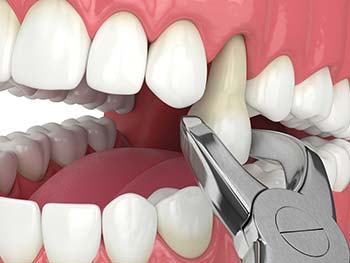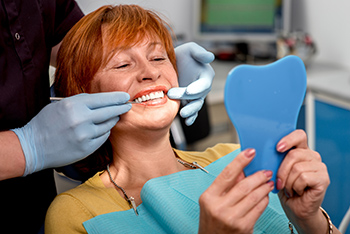
Reasons Patients Need Teeth Extractions
If you have a damaged, decayed, or diseased tooth, your dentist will weigh all restorative dentistry options to get that compromised tooth healthy. Depending on how serious the condition of the tooth, however, common restorations like root canal therapy or a tooth-colored filling may not be enough to save the tooth, and teeth extraction must be discussed.
Tooth extraction is not the end of the world. This procedure is used to eliminate a problem tooth and protect the rest of your teeth from developing problems. Extraction can stop pain and discomfort and give you a fresh slate to restore your oral health.
Some of the most likely circumstances that might lead to teeth extractions include:
- Infected tooth
- Advanced gum disease
- Severe tooth decay
- Broken tooth root
- Tooth abscess
- Bone fracture
- Jaw trauma
What to Expect with Tooth Extraction
Tooth extraction is a procedure in which a tooth is removed from its socket. There are several reasons why a tooth needs to be extracted:
- Excessive crowding
- Infection
- Excessive decay
In some cases, patients who are undergoing chemo or organ transplantation need to have compromised teeth extracted to reduce their risk of complications.
There are two types of tooth extraction: simple, in which the tooth is simply loosened and pulled from its socket, and surgical, in which the tooth must be cut from the gum and jawbone. Typically, teeth that are visible can be removed with a simple extraction, while those that are broken, impacted, or have not erupted through the gum must be removed surgically.
In most cases, only local anesthesia is used, which means patients are conscious during the procedure. However, patients with anxiety may require oral or IV sedation to relax.
Dr. Mehrdad Safavian at Capitol Square Dentistry has the experience and expertise to complete simple and surgical extractions, as well as many other dental procedures. Here’s what you need to know about recovery following tooth extraction.
Recovery after Tooth Extraction

-
First 24 hours
For the first 24 hours, it’s important to take it easy and relax. Don’t eat or drink anything until the anesthesia wears off. When you do start eating, make sure to choose foods that are soft. Also, avoid using a straw, as this could cause the blood clot to dislodge, which can impact healing.
-
48 to 72 hours
You can begin to transition to foods like rice, eggs, and other soft solids. However, you still want to avoid hard, crunchy foods, as these can cause the clot to dislodge. The site should heal enough after about a week to transition back to your normal diet.
-
Aftercare tips following tooth extraction
You will be given specific aftercare instructions following tooth extraction at Capitol Square Dentistry. However, there are some general rules to follow:
- Keep the site clean by gently rinsing with mouthwash 2 to 3 times a day. However, you will want to avoid brushing the area until the dentist tells you to.
- Take any antibiotics and pain relievers as prescribed.
- Rest for at least 48 hours, as an elevated heart rate can increase blood pressure, which can increase bleeding and discomfort. Therefore, skip the workout for at least 48 to 72 hours.
When should you call for help following tooth extractions?
If you develop the following while recovering from tooth extraction, call the office right away:
- Fever of 100.4°F or higher
- Pus/drainage around the extraction site
- Significant pain that does not improve with medication
Do You Need a Tooth Extracted?
If you have a tooth that is broken at the root or is severely decayed or damaged and needs to be extracted, schedule an appointment with Capitol Square Dentistry. Dr. Safavian can help.
Tooth Extraction FAQs
Tooth extraction is a common procedure. Still, many patients have questions and concerns. Dr. Safavian and the team at Capitol Square Dentistry will be happy to address your questions and concerns. Below are some of the most common ones we’ve answered for our patients.
-
When can I eat solid food after tooth extraction?
For the first few days following tooth extraction, you’ll want to stick with soft foods like applesauce, rice, eggs, yogurt, and pasta. You should start with applesauce, yogurt, smoothies and other liquid soft foods for the first few days. After 72 hours, you can transition to soft solids such as pasta, eggs, rice, etc. After 7 days, you can transition back to your normal diet.
-
When to stop using gauze after tooth extraction?
You should leave the gauze in for at least 30 minutes following extraction. If you are still bleeding, you’ll want to put fresh gauze in. Once the bleeding has stopped, you can stop using gauze.
-
Why no dairy after tooth extraction?
There are several reasons to avoid dairy products following tooth extraction:
- May delay healing
- May increase swelling
- May interfere with taste buds
- May cause dry socket
- May trigger infection
-
When can I smoke after tooth extraction?
You should wait for at least 24 hours before smoking following tooth extraction. This will allow time for a blood clot to form in the socket. If you smoke before this, you may dislodge the clot as it is trying to form, which can cause dry socket.
-
How long should you wait to exercise after tooth extraction?
When you are exercising, your blood pressure becomes elevated, which can cause the blood clot to dislodge. Therefore, waiting for at least 48 to 72 hours before trying to work out following tooth extraction is important.
-
Can I brush my teeth after tooth extraction?
You should wait at least 24 hours following tooth extraction before brushing your teeth and, when you do brush, make sure to use a soft-bristled toothbrush and be gentle around the extraction site. If you brush to vigorously, you may dislodge the clot, which will slow down the healing process.
-
Can I drink coffee after tooth extraction?
For the first few days following tooth extraction, you should avoid coffee and other hot beverages. In fact, it’s best to stick to water to stay hydrated and facilitate recovery. As long as things are going well, you can enjoy your coffee again after 5 days.
